 |
Marconiphone "Personal K12" mod. PB20B United Kingdom - 1948 |
 |
|
|
|||||
|
|
Description Restoration |
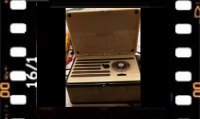 |
Descrizione Restauro |
|
|
|
|
|||||
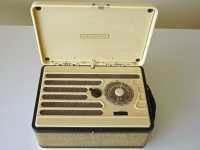 |
 |
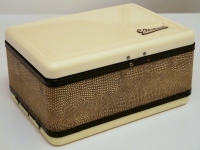 |
 |
||
 |
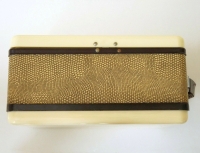 |
 |
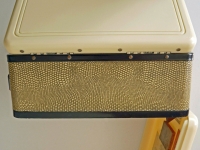 |
||
 Marconiphone
"Personal K12" mod. PB20B -
Marconi's Wireless Telegraph Co. Ltd. - United Kingdom - 1948. Marconiphone
"Personal K12" mod. PB20B -
Marconi's Wireless Telegraph Co. Ltd. - United Kingdom - 1948.Portable radio built by Marconi in the post-war period and aimed primarily at a wealthy female customers. The Personal K12 was certainly not a cheap accessory, it was made using the most modern technology of the time that had allowed it to be reduced in size to that of a small woman's handbag. The initial price in 1948 was 11 eglish pounds, which was equivalent to about 350 GPB pounds today. The radio was a superheterodyne that received Medium Waves and Long Waves and used four miniature seven-pin valves. The Marconiphone used miniature vacuum tube technology, developed during the Second World War to create small portable transceivers supplied to US infantry troops, such as the shoulder-mounted BC-1000 and the even smaller (for the time) BC-611 the first walkie talkie. The valves used in the Personal K12 were from the English Mullard: X17, W17, ZD17 and N17 which were equivalent to the RCA: 1R5, 1T4, 1S5 and 3S4. The antenna was a frame and was located inside the cover of the radio. The Intermediate Frequency of the circuit resonated at 365 kHz, the speaker was a small 3 inch magnetodynamic. For power, the device used a B114 battery which was composed of two elements, one 1.5 V and the other 69 V. The battery allowed the radio to work for about thirty hours. The cabinet of the K12 was made of metal covered with a band of what looked like snakeskin, the cover and the base were made of cream-colored plastic. The dimensions were 7 x 3 x 5 inch and the weight was 3 lb 15.4 oz. IK3HIA©2021 |
|||||
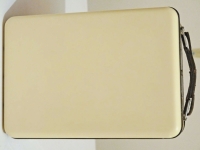 |
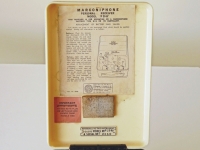 |
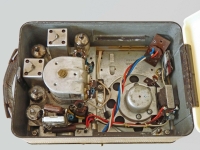 |
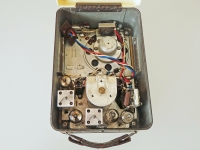 |
||
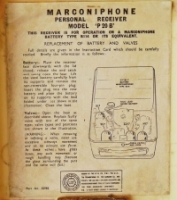 |
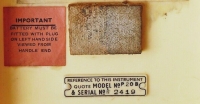 |
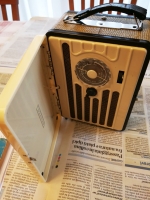 |
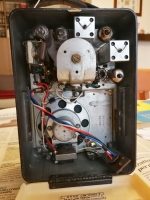 |
||
|
Back to the top of the page
|
|||||
 Restoration
RestorationTo tell the truth, the Marconiphone Personal K12 serial number 2419 that I received didn't need much work to get back to working properly. I measured the efficiency of the valves with the TV7-U Tube Tester but they were all fine. To be safe, I disassembled the chassis and replaced the two electrolytic capacitors C19 and C20, carefully emptying the original containers and inserting modern components with higher capacity and insulation voltage. After reassembling the device, I powered it with my multi-voltage power supply and opened the lid to turn on the radio. Some noise came out of the speaker and by turning the tuning knob I managed to pick up a few stations. To complete the job, I used the Heathkit SG-8 modulated oscillator, connecting the probe with the 365 kHz signal to the variable capacitor VC and quickly calibrating the IFT1 and IFT2 IF transformers. After turning the K12 back on, I tuned in a station and verified that voices and sounds were good. After seventy-three years the small portable Marconiphone radio was still working well, too bad that today the Medium Waves and Long Waves are almost completely deserted, so I consoled myself by enjoying a good espresso coffee. IK3HIA © 2021 |
|||||
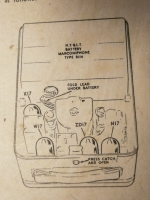 |
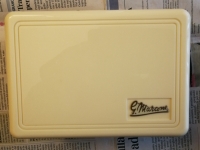 |
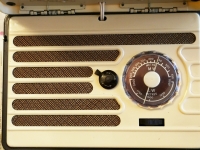 |
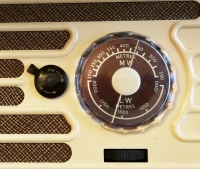 |
||
 Marconiphone
"Personal K12" mod. PB20B -
Marconi's Wireless Telegraph Co. Ltd. - Regno Unito - 1948. Marconiphone
"Personal K12" mod. PB20B -
Marconi's Wireless Telegraph Co. Ltd. - Regno Unito - 1948.Apparecchio radio portatile costruito dalla Marconi nel primo dopoguerra e indirizzato principalmente a una ricca clientela femminile. Il Personal K12 non era sicuramente un accessorio economico, era stato realizzato utilizzando la tecnologia più moderna dell'epoca che aveva permesso di ridurne le dimensioni a quelle di una piccola borsetta da donna. Il prezzo iniziale nel 1948 era di 11 sterline, che equivalevano a circa 350 sterline attuali. La radio era una supereterodina che riceveva le Onde Medie e le Onde Lunghe e impiegava quattro valvole miniatura a sette piedini. La Marconiphone utilizzava la tecnologia dei tubi a vuoto miniatura, sviluppata durante la Seconda Guerra Mondiale per realizzare piccoli ricetrasmettitori portatili in dotazione alle truppe di fanteria USA, come ad esempio lo spalleggiabile BC-1000 e l'ancora più piccolo (per l'epoca) BC-611 il primo walkie talkie. Le valvole impiegate nella Personal K12 erano della inglese Mullard: X17, W17, ZD17 e N17 che equivalevano alle RCA: 1R5, 1T4, 1S5 e 3S4. L'antenna era a telaio ed era situata all'interno del coperchio della radio. La Frequenza Intermedia del circuito risuonava a 365 kHz, l'altoparlante era un piccolo magnetodinamico da 7.5 cm. Per l'alimentazione l'apparecchio utilizzava una batteria B114 che era composta da due elementi, uno da 1,5 V e l'altro da 69 V. La batteria permetteva alla radio di funzionare per una trentina di ore. Il mobiletto della K12 era di metallo rivestito da una fascia di quella che sembrava pelle di serpente, il coperchio e la base erano di plastica color panna. Le dimensioni erano 17 x 7,6 x 12,7 cm e il peso di 1.8 kg. IK3HIA©2021 |
|||||
|
Back to the top of the page
|
|||||
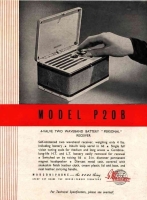 |
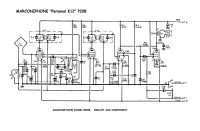 |
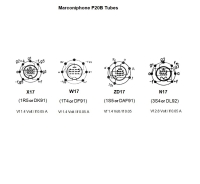 |
 |
||
 Restauro
Restauro A dire la verità, la Marconiphone Personal K12 matricola 2419 arrivata in mio possesso non aveva bisogno di molto lavoro per tornare a funzionare correttamente. Ho misurato l'efficienza delle valvole con il provavalvole TV7-U ma erano tutte a posto. Per sicurezza ho smontato lo chassis e ho sostituito i due condensatori elettrolitici C19 e C20 svuotando con cautela i contenitori originali e inserendovi dei componenti moderni con capacità e tensione di isolamento superiori. Dopo aver rimontato l'apparecchio l'ho alimentato con il mio alimentatore multi tensione e ho aperto il coperchio per accenderlo. Dall'altoparlante è uscito del fruscio e ruotando la manopola della sintonia sono riuscito a captare qualche stazione. Per completare il lavoro ho utilizzato l'oscillatore modulato Heathkit SG-8 collegando la sonda con il segnale a 365 kHz al condensatore variabile VC ed effettuando una veloce taratura dei trasformatori di Media Frequenza IFT1 e IFT2. Riaccesa la K12 ho sintonizzato una stazione e ho verificato che voci e suoni risultassero più forti. Dopo settantatrè anni la piccola radio portatile della Marconiphone era ancora ben funzionante, peccato che oggi le Onde Medie e le Onde Lunghe siano quasi completamente deserte, perciò mi sono consolato gustando un buon caffè espresso. IK3HIA©2021 |
|||||
 |
 |
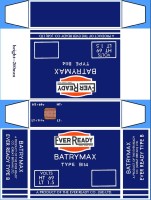 |
|||
|
Back to the top of the page
|
|||||